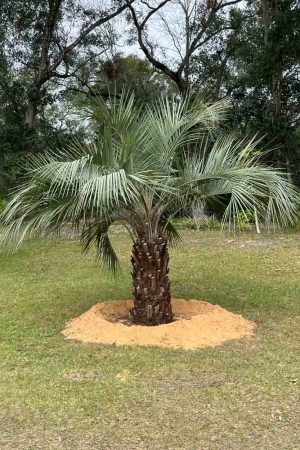PINDO PALM
We have transplanted hundreds of Pindo Palms. There is no other palm that is so hardy. We have learned over the years that this palm is either loved or hated. There is no in between. We believe the hate factor is due to the color, which is an off blue, or a dirty blue/gray. It isn’t really tremendously popular although it should be. It is hardy, cold tolerant, never grows too big for itself, is easy to maintain, and fills up a lot of space. The trunk can also be ‘diamond cut’ to give it a real nice specimen look.
Striking in appearance, the Pindo’s feather-leaf, silver-colored fronds (some describe them as more blue-green) create a stunning contrast to typical yard greenery. These hardy palms thrive in South Florida, enduring cold, blazing sun, salt air, and dry conditions.
Sometimes called “Jelly Palm,” the Pindo is a native plant that produces edible berries, which can be made into jelly with a sweet banana/pineapple flavor. The palm’s unique yet versatile look suits small yards, complementing a modest beach house, an old-fashioned Florida bungalow, or a ranch-style home. Pindo palms also enhance large woodland estates, horse ranches, or waterfront homes with their bright presence.
The Pindo Palm Tree, scientific name Butia capitata, is popular worldwide for its stunning appearance, cold hardiness, and bright yellow fruit, which can be made into jelly. Its graceful blue-green fronds are ideal for pool-side plantings and container use. It is one of the most popular Florida Palm Trees and can live up to 80 years. Also known as Jelly Palm and Wine Palm, it is native to Brazil, Uruguay, and Argentina. It has a heavy gray trunk covered with old leaf bases, about 15 ft tall and 1-1.5 ft in diameter, with some specimens having a clean trunk. Without a crownshaft, beautiful arching leaves emerge directly from the trunk. The leaves are pinnate, or feather-like, ranging from green to bluish-gray, about 5-10 ft long, with 80-150 leaflets around 20-26 inches long, supported by 3-4 ft long petioles with spines along both edges.
In late spring, the Pindo Palm produces small yellow to orange-red flowers in clusters on large 3-4 ft long inflorescences. The flowers are monoecious, with both male and female flowers on the same plant, pollinated by insects and wind. These are followed by bright orange fruits, known as “pindo dates,” hanging in large clusters. The dates are round to oval-shaped, juicy, and edible, about 1 inch in diameter, maturing in summer. They can be eaten fresh, pureed, or used to make jams and wine. The fruits can be stored for about a week in the refrigerator but can create a mess when ripe fruits fall.
The growth rate is slow to moderate. Butia capitata can grow up to 10–20 ft tall and 10-15 ft wide, but usually remains under 15 ft with a 10 ft spread. The Pindo Palm can tolerate cold down to 5°F when mature, thriving in USDA Zones 7b (5 to 10°F) to 11 (above 40°F). It thrives in partial shade to full sun with moderate water requirements. The Pindo Palm is tolerant of salt water, drought, and weather stresses when mature, and can grow in clay or sandy soils. It requires plenty of water until established in the first 2 years, but afterward, only little to moderate watering is needed.
This palm is easy to maintain, offering low to moderate maintenance. To prevent nutritional deficiency, apply good quality palm fertilizer with a continuous release formula twice a year during the growing season. The Pindo Palm usually doesn’t face significant insect or disease issues, though palm leaf skeletonizer, scale, and micronutrient deficiencies are occasional problems. There are no major diseases to worry about, although the Pindo Palm can suffer root rot if the soil is too moist and not well-drained.

